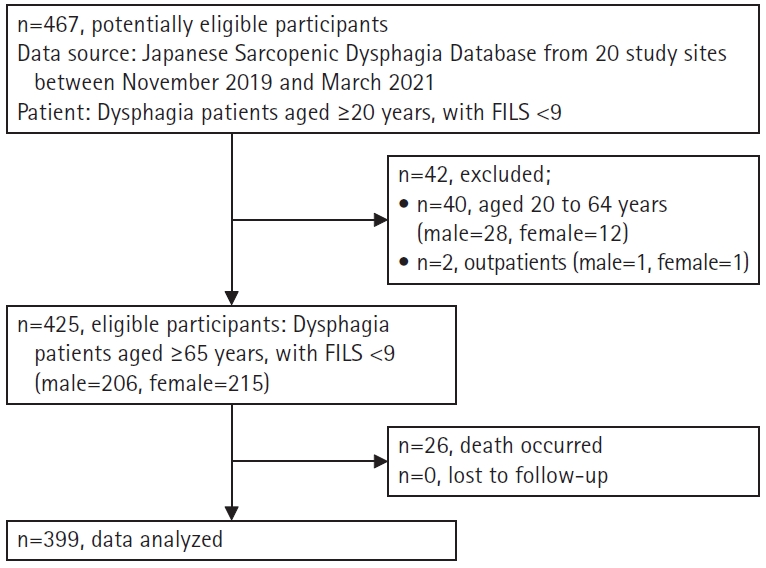 |
 |
- Search
| Ann Geriatr Med Res > Volume 28(1); 2024 > Article |
|
Abstract
Background
Methods
Results
Conclusion
ACKNOWLEDGMENTS
We thank all the collaborators from the Japanese Working Group on Sarcopenic Dysphagia for their clinical work, data collection, and data registration.
SUPPLEMENTARY MATERIALS
Fig.┬ĀS1.
Fig.┬ĀS2.
Fig.┬ĀS3.
Fig.┬ĀS4.
Fig.┬ĀS5.
Table┬ĀS1.
Table┬ĀS3.
Table┬ĀS4.
Table┬ĀS5.
Fig.┬Ā1.

Table┬Ā1.
Table┬Ā2.
Table┬Ā3.
| Variable | Overall | With polypharmacy | Without polypharmacy | p-valuea) |
|---|---|---|---|---|
| Overall | 399 | 270 | 120 | Polypharmacy (<0.001) |
| ŌĆāFILS at baseline | 7.0 (4.0ŌĆō8.0) | 7.0 (6.0ŌĆō8.0) | 7.0 (2.0ŌĆō7.0) | Times (<0.001) |
| ŌĆāFILS at follow-up | 8.0 (7.0ŌĆō8.0) | 8.0 (7.0ŌĆō8.0) | 8.0 (7.0ŌĆō8.0) | Time├ŚPolypharmacy (0.411) |
| Acute care hospital | 164 | 104 | 60 | Polypharmacy (0.040) |
| ŌĆāFILS at baseline | 6.0 (1.0ŌĆō7.0) | 6.0 (1.0ŌĆō7.0) | 4.5 (1.0ŌĆō7.0) | Times (<0.001) |
| ŌĆāFILS at follow-up | 7.0 (7.0ŌĆō8.0) | 7.0 (7.0ŌĆō8.0) | 7.0 (6.0ŌĆō8.0) | Time├ŚPolypharmacy (0.615) |
| Rehabilitation hospital | 186 | 142 | 44 | Polypharmacy (0.086) |
| ŌĆāFILS at baseline | 7.0 (7.0ŌĆō8.0) | 7.0 (7.0ŌĆō8.0) | 7.0 (6.8ŌĆō8.0) | Times (<0.001) |
| ŌĆāFILS at follow-up | 8.0 (7.0ŌĆō8.0) | 8.0 (7.0ŌĆō8.0) | 8.0 (7.0ŌĆō8.0) | Time├ŚPolypharmacy (0.643) |
| Long-term care hospital | 40 | 24 | 16 | Polypharmacy (0.364) |
| ŌĆāFILS at baseline | 7.0 (6.0ŌĆō8.0) | 8.0 (6.5ŌĆō8.0) | 7.0 (4.0ŌĆō7.0) | Times (0.051) |
| ŌĆāFILS at follow-up | 8.0 (6.8ŌĆō8.0) | 7.5 (6.8ŌĆō8.0) | 8.0 (6.8ŌĆō8.2) | Time├ŚPolypharmacy (0.146) |
Table┬Ā4.
FILS, Food Intake LEVEL Scale; NSAIDs, non-steroidal anti-inflammatory drugs; PIMs, potentially inappropriate medications; ╬▓, unstandardized coefficient; SE, Standard error; CI, confidence interval.
Model 1 represents ŌĆ£polypharmacy (without polypharmacy=0, as reference, or with polypharmacy=1) + age + gender + primary diagnosis at hospitalization + Charlson Comorbidity Index + FILS at baseline + hospital type were introduced into the analytical models,ŌĆØ Model 2 represents ŌĆ£Model 1 + general sarcopenia were introduced into the analytical models,ŌĆØ and Model 3 represents ŌĆ£Model 2 + primary diseases were introduced into the analytical models.ŌĆØ
REFERENCES
- TOOLS
-
 PDF Links
PDF Links PubReader
PubReader ePub Link
ePub Link XML Download
XML Download-
 Full text via DOI
Full text via DOI
 Full text via PMC
Full text via PMC-
 Download Citation
Download Citation
 agmr-23-0203-Supplementary-Fig-S1.pdf
agmr-23-0203-Supplementary-Fig-S1.pdf agmr-23-0203-Supplementary-Fig-S2.pdf
agmr-23-0203-Supplementary-Fig-S2.pdf agmr-23-0203-Supplementary-Fig-S3.pdf
agmr-23-0203-Supplementary-Fig-S3.pdf agmr-23-0203-Supplementary-Fig-S4.pdf
agmr-23-0203-Supplementary-Fig-S4.pdf agmr-23-0203-Supplementary-Fig-S5.pdf
agmr-23-0203-Supplementary-Fig-S5.pdf agmr-23-0203-Supplementary-Table-S1.pdf
agmr-23-0203-Supplementary-Table-S1.pdf agmr-23-0203-Supplementary-Table-S2.pdf
agmr-23-0203-Supplementary-Table-S2.pdf agmr-23-0203-Supplementary-Table-S3.pdf
agmr-23-0203-Supplementary-Table-S3.pdf agmr-23-0203-Supplementary-Table-S4.pdf
agmr-23-0203-Supplementary-Table-S4.pdf agmr-23-0203-Supplementary-Table-S5.pdf
agmr-23-0203-Supplementary-Table-S5.pdf agmr-23-0203-Supplementary-File.pdf
agmr-23-0203-Supplementary-File.pdf







